The Scientific Reference Model—A Methodological Approach in the Hypothetical 3D Reconstruction of Art and Architecture
Abstract
1. Introduction
2. Reality-Based Model, Sourced-Based Model, and Modelling Methods
3. Scientific Reference Model
3.1. Object Identification
3.2. Sources
3.3. Normative Structure
3.4. Segmentation
3.5. 3D Modelling
3.6. Documentation
3.7. Publication
4. Conclusions
Author Contributions
Funding
Data Availability Statement
Acknowledgments
Conflicts of Interest
References
- Brink, A. Anfertigung Wissenschaftlicher Arbeiten [Preparation of Scientific Papers]; Springer Gabler: Wiesbaden, Germany, 2013. [Google Scholar] [CrossRef]
- Münster, S.; Apollonio, F.I.; Bluemel, I.; Fallavollita, F.; Foschi, R.; Grellert, M.; Ioannides, M.; Jahn, P.H.; Kurdiovsky, R.; Kuroczyński, P.; et al. Documentation. In Handbook of Digital 3D Reconstruction of Historical Architecture; Synthesis Lectures on Engineers, Technology, & Society; Springer: Cham, Switzerland, 2024; Volume 28, pp. 165–187. [Google Scholar] [CrossRef]
- Kuroczyński, P.; Bajena, I.P.; Große, P.; Jara, K.; Wnęk, K. Digital Reconstruction of the New Synagogue in Breslau: New Approaches to Object-Oriented Research. In Research and Education in Urban History in the Age of Digital Libraries; Niebling, F., Münster, S., Messemer, H., Eds.; UHDL 2019 Communications in Computer and Information Science; Springer: Cham, Switzerland, 2021; Volume 1501, pp. 25–45. [Google Scholar] [CrossRef]
- Bajena, I.; Kuroczyński, P. Development of the methodology and infrastructure for digital 3D reconstruction. In AMPS Proceedings Series 29.2, Proceedings of the (IN)TANGIBLE HERITAGE(S): A Conference on Design, Culture and Technology—Past, Present, and Future, Canterbury, UK, 15–17 June 2022; University of Kent: Canterbury, UK, 2023; pp. 72–83. ISSN 2398-9467. Available online: https://tiny.pl/w26jp (accessed on 8 March 2023).
- ‘Synagoga w Wołpie’. Wikipedia. 2023. Available online: https://pl.wikipedia.org/wiki/Synagoga_w_Wo%C5%82pie (accessed on 17 March 2023).
- ‘Wolpa Synagogue’. Wikidata. 2022. Available online: https://www.wikidata.org/wiki/Q3508102 (accessed on 17 March 2023).
- Bajena, I.P.; Cazzaro, I.; Kuroczyński, P. Handout for Source-Based 3D Reconstruction on the Example of the Former Synagogue in Speyer in 1250; Zenodo. 2022. [Google Scholar]
- DIN EN ISO 19650-1:2019-08; Organisation und Digitalisierung von Informationen zu Bauwerken und Ingenieurleistungen, einschließlich Bauwerksinformationsmodellierung_(BIM)_- Informationsmanagement mit BIM_- Teil_1: Begriffe und Grundsätze (ISO_19650-1:2018); Deutsche Fassung EN_ISO_19650-1:2018. (n.d.). DIN Media GmbH: Berlin, Germany, 2019. [CrossRef]
- ‘The Getty Research Institute, Art & Architecture Thesaurus® Online’. 2010. Available online: https://www.getty.edu/research/tools/vocabulary/aat/ (accessed on 17 March 2023).
- Open Geospatial Consortium. CityGML. 2021. Available online: https://www.ogc.org/standard/citygml/ (accessed on 17 March 2023).
- DIN EN ISO 16739-1:2021-11; Industry Foundation Classes (IFC) for Data. (n.d.). DIN Media GmbH: Berlin, Germany, 2021. Available online: https://shop.standards.ie/en-ie/standards/din-en-iso-16739-1-2021-11-1277906_saig_din_din_3070545/ (accessed on 11 September 2024).
- Kuroczyński, P.; Apollonio, F.I.; Bajena, I.; Cazzaro, I. Scientific Reference Model—Defining standards, methodology and implementation of serious 3D models in archaeology, art and architecture history. In The International Archives of the Photogrammetry, Remote Sensing and Spatial Information Sciences; The International Society for Photogrammetry and Remote Sensing: Bethesda, MD, USA, 2023; Volume XLVIII-M-2-2023. [Google Scholar] [CrossRef]
- Pfarr-Harfst, M. Typical Workflows, Documentation Approaches and Principles of 3D Digital Reconstruction of Cultural Heritage. In 3D Research Challenges in Cultural Heritage II (Lecture Notes in Computer Science); Münster, S., Pfarr-Harfst, M., Kuroczyński, P., Ioannides, M., Eds.; Springer International Publishing: Cham, Switzerland, 2016; pp. 32–46. [Google Scholar] [CrossRef]
- Münster, S.; Friedrichs, K.; Hegel, W. 3D Reconstruction Techniques as a Cultural Shift in Art History? Int. J. Digit. Art Hist. 2018, 3, 39–59. [Google Scholar] [CrossRef]
- Münster, S. Digital 3D Technologies for Humanities Research and Education: An Overview. Appl. Sci. 2022, 12, 2426. [Google Scholar] [CrossRef]
- ICOMOS General Assembly. Principles of Seville, International Principles of Virtual Archaeology. 2017. Available online: http://sevilleprinciples.com/ (accessed on 5 October 2022).
- London Charter Initiatives. The London Charter. 2006. Available online: https://www.londoncharter.org/ (accessed on 5 October 2022).
- Pfarr-Harfst, M. Documentation system for digital reconstructions. Reference to the Mausoleum of the Tang-Dynastie at Zhaoling, in Shaanxi Province, China. In Proceedings of the 16th International Conference on “Cultural Heritage and New Technologies”, Vienna, Austria, 2–4 November 2011; pp. 648–658. Available online: https://archiv.chnt.at/wp-content/uploads/eBook_CHNT16_Part4.pdf (accessed on 16 March 2023).
- Apollonio, F.I. Classification Schemes for Visualization of Uncertainty in Digital Hypothetical Reconstruction. In 3D Research Challenges in Cultural Heritage II (Lecture Notes in Computer Science); Münster, S., Pfarr-Harfst, M., Kuroczyński, P., Ioannides, M., Eds.; Springer International Publishing: Cham, Switzerland, 2016; pp. 173–197. [Google Scholar] [CrossRef]
- Martens, B.; Herbert, P. Virtual Reconstruction of Synagogues Systematic Maintenance of Modeling Data. In Proceedings of the 20th eCAADe Conference Proceedings, Warsaw, Poland, 18–20 September 2002; pp. 512–517, ISBN 0-9541183-0-8. [Google Scholar] [CrossRef]
- Grellert, M.; Apollonio, F.I.; Martens, B.; Nußbaum, N. Working Experiences with the Reconstruction Argumentation Method (RAM)—Scientific Documentation for Virtual Reconstruction. In Proceedings of the 23rd International Conference on Cultural Heritage and New Technologies, Vienna, Austria, 15–17 November 2018; Volume 23, pp. 1–14. Available online: https://archiv.chnt.at/wp-content/uploads/eBook_CHNT23_Grellert.pdf (accessed on 17 March 2023).
- Kowal, S.; Koszewski, K.; Słyk, J.; Wrona, S. Digital Method for Verifying Archaeological Hypotheses. Medieval Gord Under Pułtusk Castle. Stud. Digit. Herit. 2017, 1, 444–455. [Google Scholar] [CrossRef][Green Version]
- Kensek, K.M. A survey of methods for showing missing data, multiple alternatives, and uncertainty in reconstructions. CSA Newsletter 2007, 19. Available online: https://csanet.org/newsletter/winter07/nlw0702.html (accessed on 28 September 2023).
- Favre-Brun, A. Architecture Virtuelle et Représentation de L’incertitude: Analyse des Solutions de Visualisation de la Représentation 3D. Application à L’église de la Chartreuse de Villeneuve-lez-Avignon (Gard) et à L’abbaye Saint-Michel de Cuxa (Pyrénées-Orientales). Ph.D. Thesis, Université d’Aix-Marseille, Marseille, France, 2013. [Google Scholar]
- Apollonio, F.I.; Fallavollita, F.; Foschi, R. The Critical Digital Model for the Study of Unbuilt Architecture. In Research and Education in Urban History in the Age of Digital Libraries (Communications in Computer and Information Science); Niebling, F., Münster, S., Messemer, H., Eds.; Springer International Publishing: Cham, Switzerland, 2021; pp. 3–24. [Google Scholar] [CrossRef]
- Young, T. The Bakerian Lecture. On the Theory of Light and Colours. Philos. Trans. R. Soc. 1802, 92, 12–48. [Google Scholar] [CrossRef]
- Hering, E. Zur Lehre vom Lichtsinne. Sechs Mittheilungen an die Kaiserl. Akademie der Wissenschaften in Wien; Carl Gerold’s Sohn: Vienna, Austria, 1878. [Google Scholar]
- Stone, M. Choosing Colors for Data Visualization. Percept. Edge 2006, 2, 344–347. [Google Scholar] [CrossRef]
- Wacker, M.; Stille, W.; Grellert, M.; Bruschke, J.; Beck, D. IDOVIR—Infrastructure for Documentation of Virtual Reconstructions—Towards a Documentation Practice for Everyone. In Proceedings of the 27th International Conference on Cultural Heritage and New Technologies, Cultural Heritage—NextGen Innovative Approaches in Documentation, Research, Management and Education, Vienna, Austria, 10–12 November 2022; CHNT Editorial Board. Available online: https://chnt.at/wp-content/uploads/2022/09/ID057_WACKER.pdf (accessed on 16 March 2023).
- Berners-Lee, T.; Hendler, J.; Lassila, O. The semantic Web: A new form of Web content that is meaningful to computers will unleash a revolution of new possibilities. Sci. Am. 2001, 284, 34. Available online: https://www-sop.inria.fr/acacia/cours/essi2006/Scientific%20American_%20Feature%20Article_%20The%20Semantic%20Web_%20May%202001.pdf (accessed on 17 March 2023). [CrossRef]
- Wilkinson, M.D.; Dumontier, M.; Aalbersberg, I.J.; Appleton, G.; Axton, M.; Baak, A.; Blomberg, N.; Boiten, J.W.; da Silva Santos, L.B.; Bourne, P.E.; et al. The FAIR Guiding Principles for scientific data management and stewardship. Sci. Data 2016, 3, 160018. [Google Scholar] [CrossRef] [PubMed]
- Bruseker, G.; Carboni, N.; Guillem, A. Cultural Heritage Data Management: The Role of Formal Ontology and CIDOC CRM. In Heritage and Archaeology in the Digital Age: Acquisition, Curation, and Dissemination of Spatial Cultural Heritage Data (Quantitative Methods in the Humanities and Social Sciences); Vincent, M.L., López-Menchero Bendicho, V.M., Ioannides, M., Levy, T.E., Eds.; Springer International Publishing: Cham, Switzerland, 2017; pp. 93–131. [Google Scholar] [CrossRef]
- Ronzino, P.; Amico, N.; Niccolucci, F. Assessment and Comparison of Metadata Schemas for Architectural Heritage, 2011. In Proceedings of the Cipa Symposium 23, Prague, Czech Republic, 12–16 September 2011; Available online: https://www.cipaheritagedocumentation.org/wp-content/uploads/2018/12/Ronzino-e.a.-Assessment-and-comparison-of-metadata-schemas-for-architectural-heritage.pdf (accessed on 16 March 2023).
- Bajena, I.; Kuroczyński, P. Metadata for 3D Digital Heritage Models. In the Search of a Common Ground. In Research and Education in Urban History in the Age of Digital Libraries; Münster, S., Pattee, A., Kröber, C., Niebling, F., Eds.; Communications in Computer and Information Science; Springer: Cham, Switzerland, 2023; Volume 1853. [Google Scholar] [CrossRef]
- World Wide Web Consortium—W3C. RDF—Semantic Web Standards. 2014. Available online: https://www.w3.org/RDF/ (accessed on 17 March 2023).
- Berners-Lee, T. Five Star Open Data. 2012. Available online: https://5stardata.info/en/ (accessed on 5 October 2022).
- European Commission. Basic Principles and Tips for 3D Digitisation of Cultural Heritage. 2020. Available online: https://digital-strategy.ec.europa.eu/library/basic-principles-and-tips-3d-digitisation-cultural-heritage (accessed on 17 March 2023).
- Albrezzi, F.; Bonnett, J.; Gniady, T.; Richards-Rissetto, H.; Snyder, L. Accessing 3D Data. In 3D Data Creation to Curation: Community Standards for 3D Data Preservation, Association of College and Research Libraries; Moore, J., Rountrey, A., Kettler, H.S., Eds.; Anthropology Faculty Publications; American Library Association: Chicago, IL, USA, 2022; pp. 259–295. Available online: https://bit.ly/ACRL3Ddata (accessed on 15 March 2023).
- Kuroczyński, P.; Große, P. OntSciDoc3D—Ontology for Scientific Documentation of Source-Based 3D Reconstruction of Architecture. In Proceedings of the 25th International Conference on Cultural Heritage and New Technologies CHNT 25, Vienna, Austria, 4–6 November 2020; Available online: https://www.academia.edu/89958997/Ontology_for_Scientific_Documentation_of_source_based_3D_reconstruction_of_architecture (accessed on 3 July 2024).
- Bajena, I.P.; Dworak, D.; Kuroczyński, P.; Smolarski, R.; Münster, S. DFG 3D-Viewer—Development of an infrastructure for digital 3D reconstructions. In Proceedings of the Digital Humanities 2022. Responding to Asian Diversity. Conference Abstracts, DH2022 Local Organizing Committee, Tokyo, Japan, 25–29 July 2022; Available online: https://www.researchgate.net/publication/362814222_DFG_3D-Viewer_-_Development_of_an_infrastructure_for_digital_3D_reconstructions (accessed on 3 July 2024).
- ‘CoVHer—Computer-Based Visualisation of Architectural Cultural Heritage’. EU Erasmus+ Project, 2022–2025. Available online: https://covher.eu/ (accessed on 1 July 2024).
- Bajena, I.; Kuroczyński, P. WissKI 3D Repository as a tool for the preservation and exploration of 3D models of cultural heritage. In Proceedings of the eXploЯA, Virtual Journeys do Discover Inaccessible Heritages, Rome, Italy, 15–17 March 2024. [Forthcoming]. [Google Scholar]
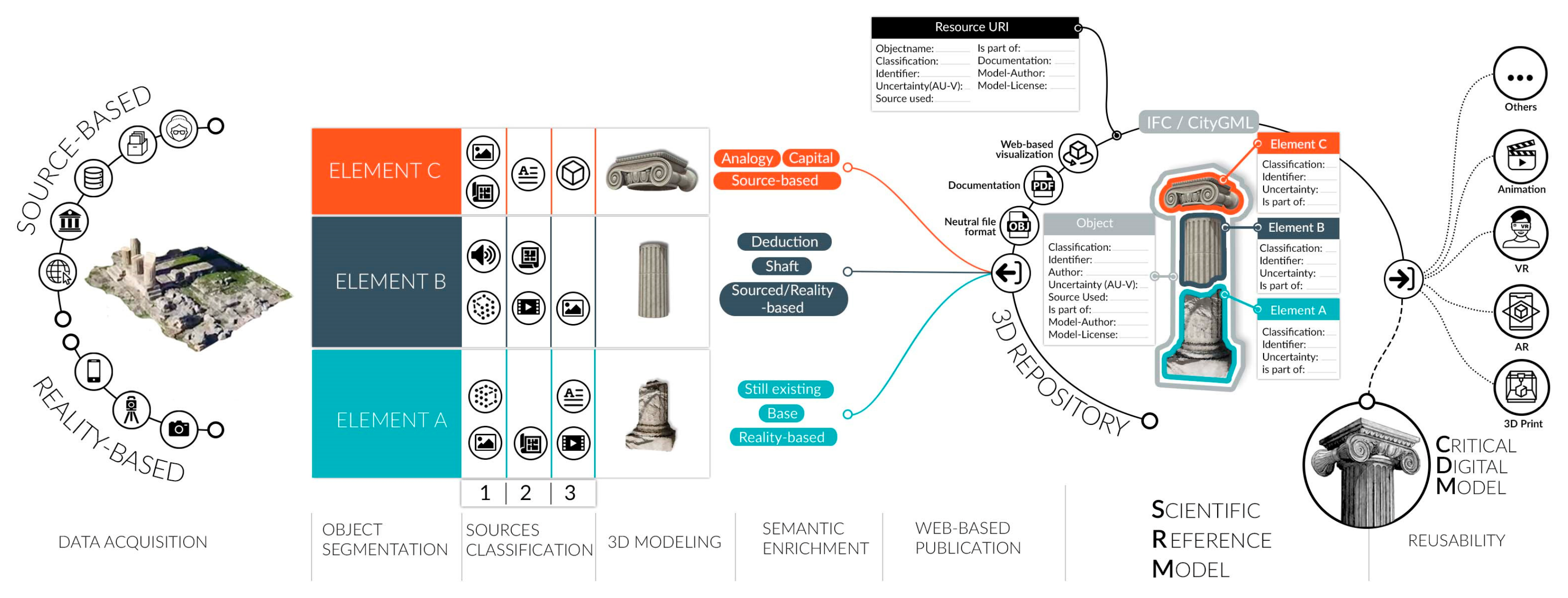


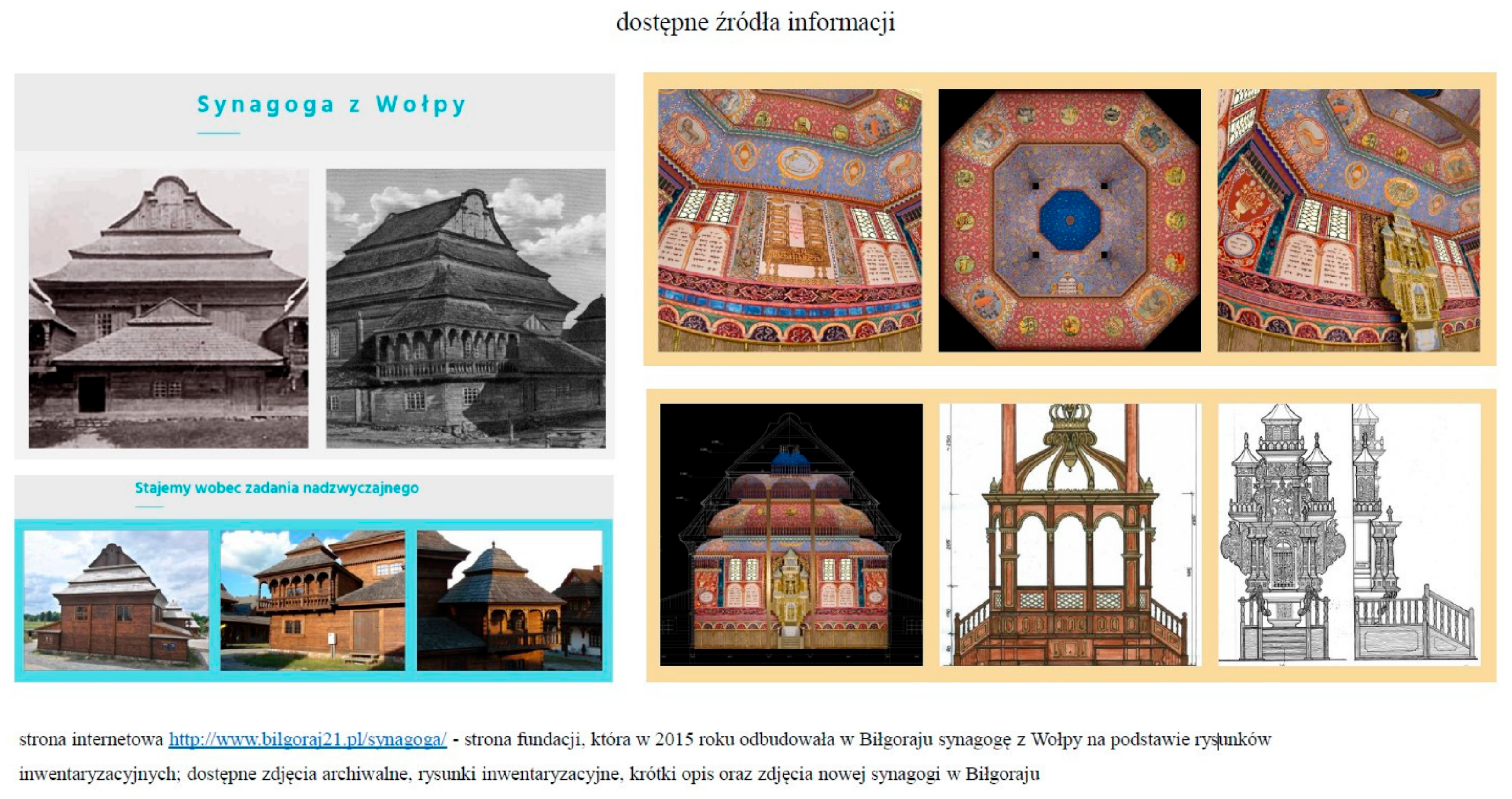

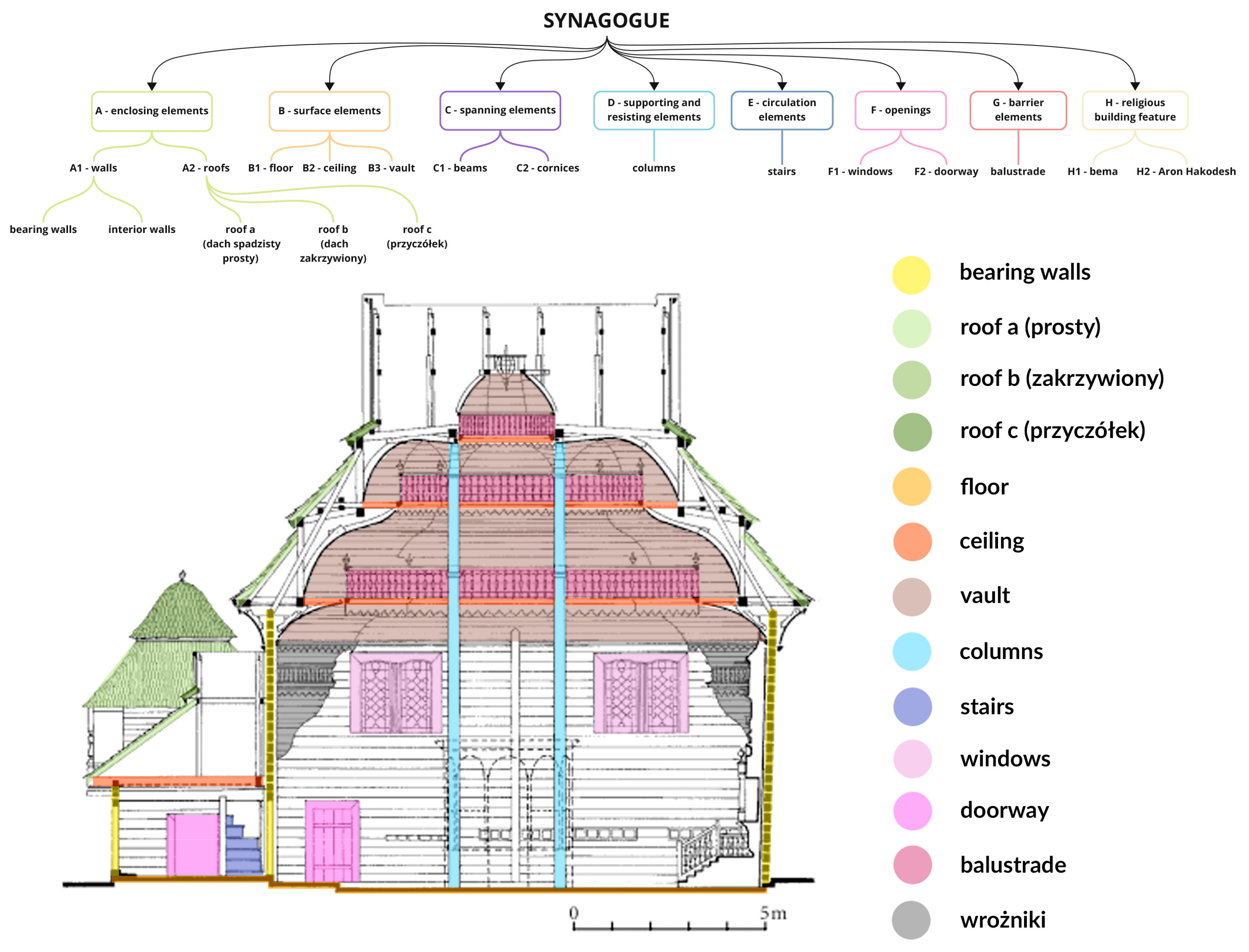
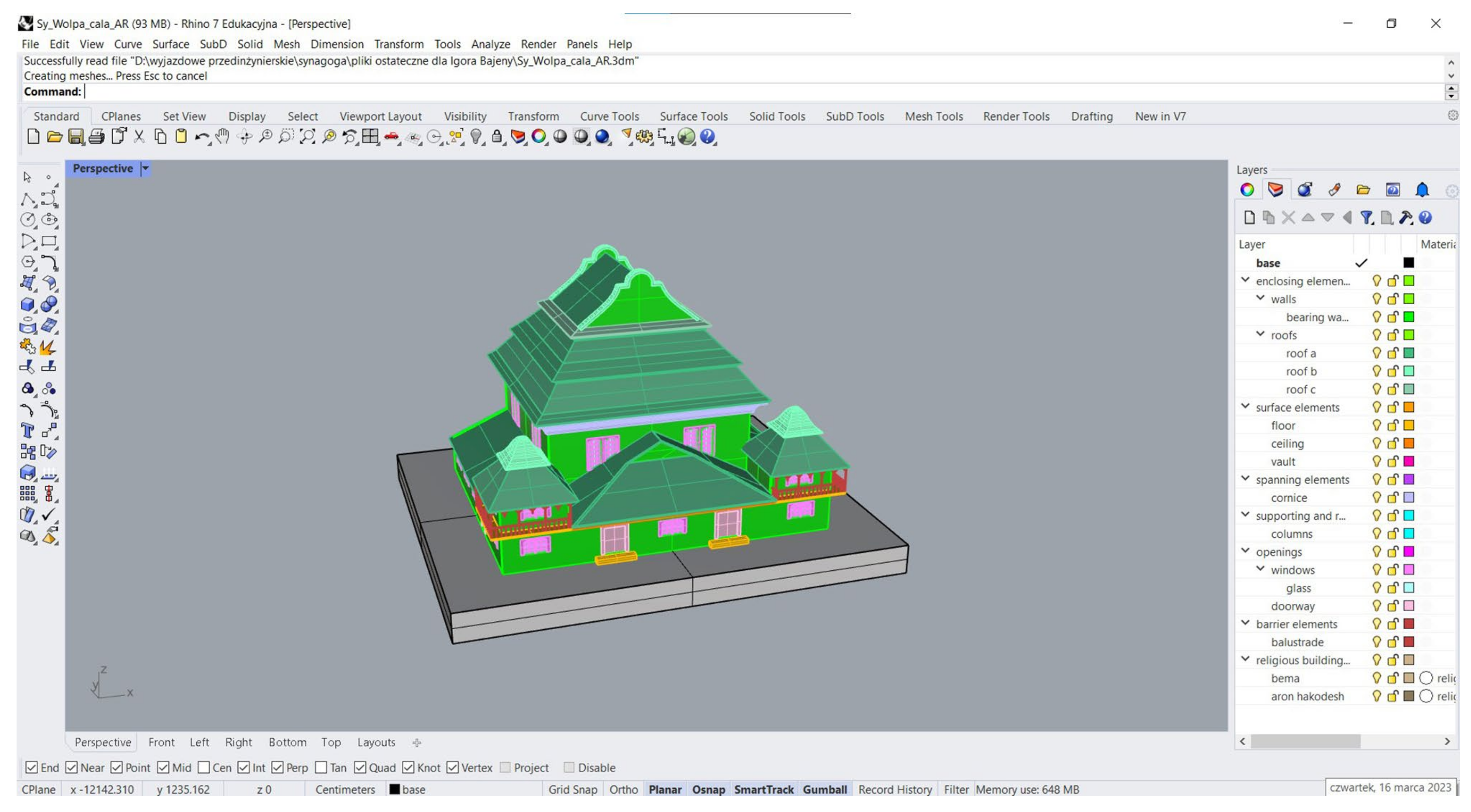
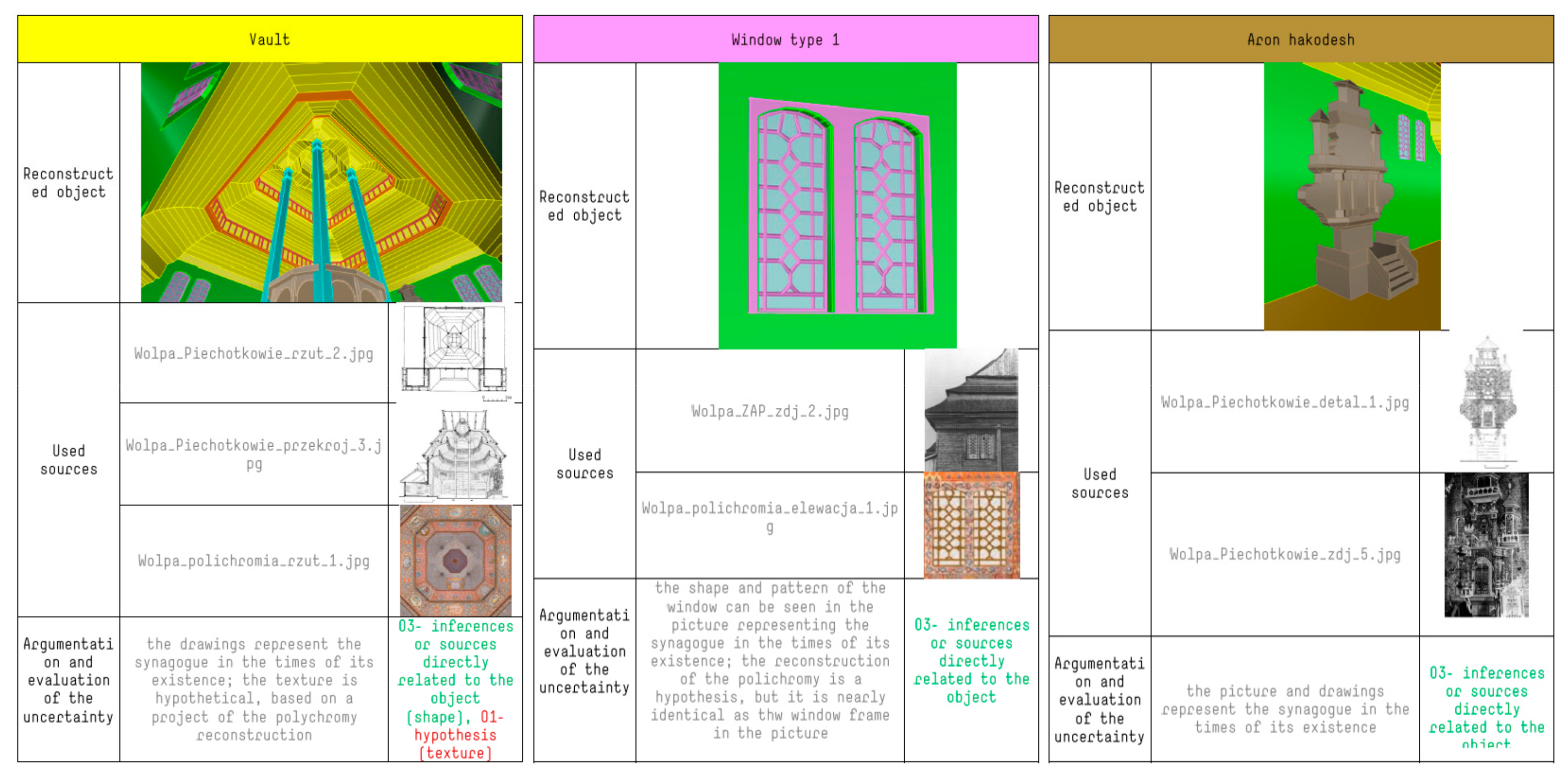

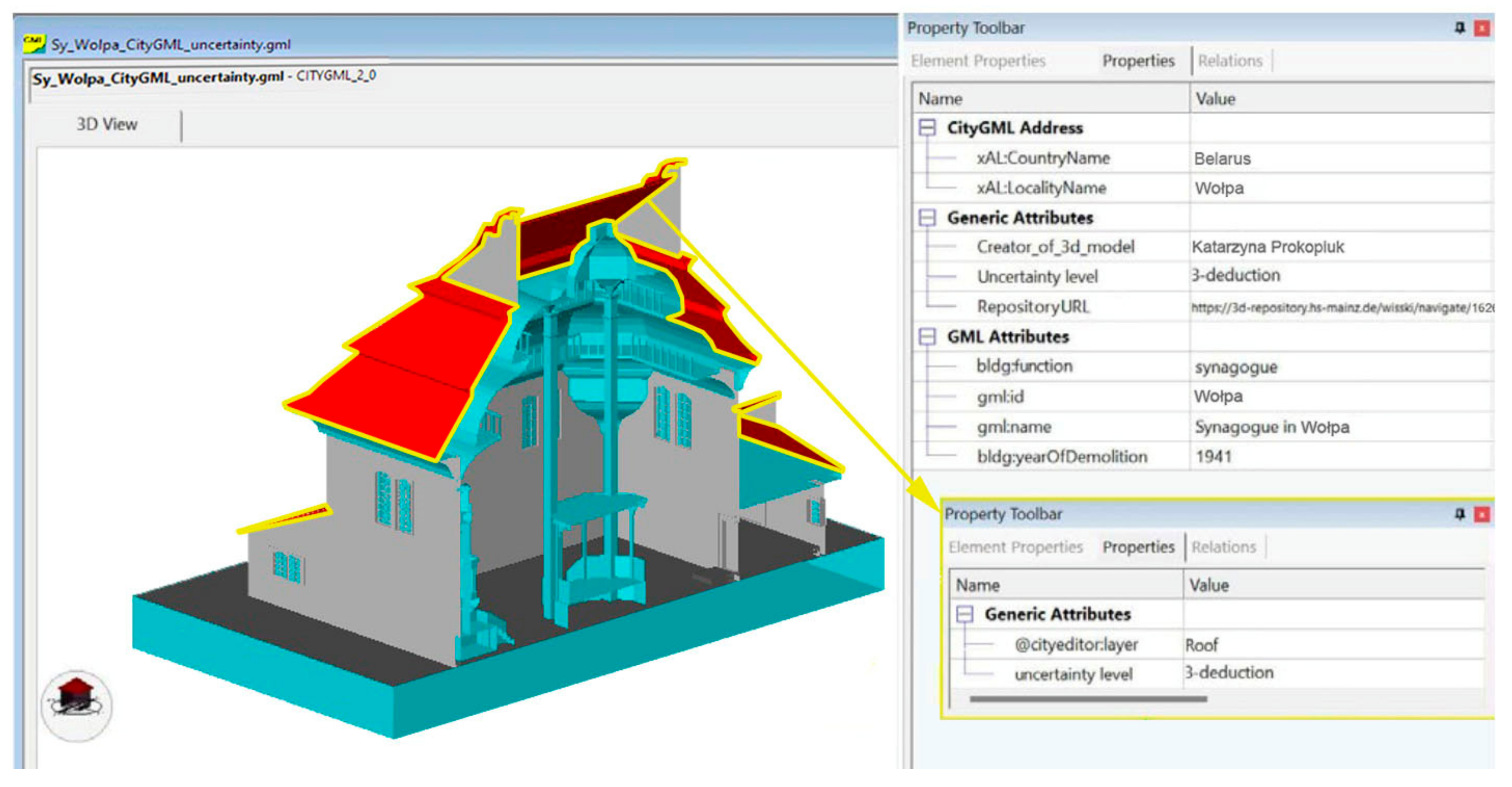
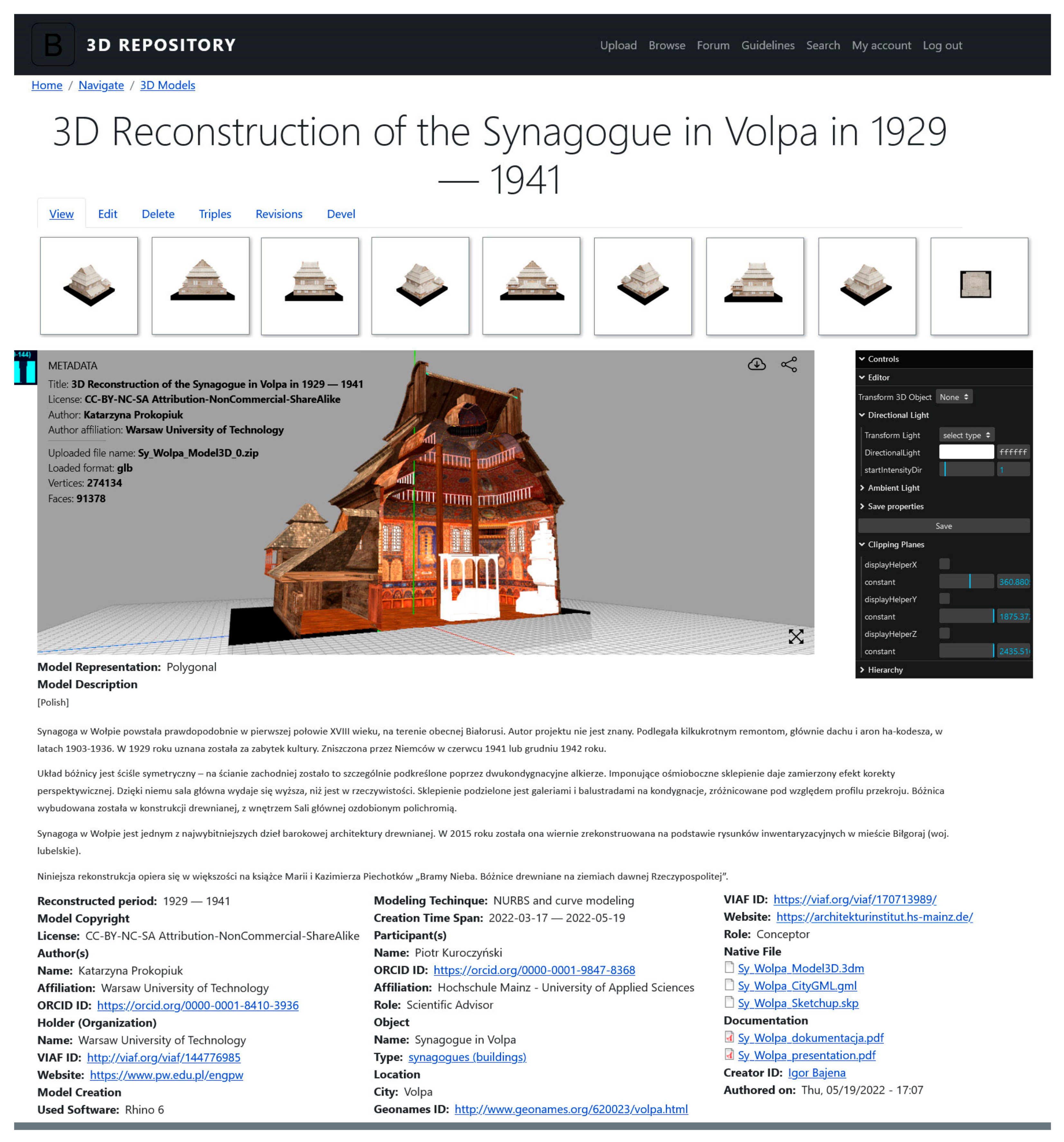

Disclaimer/Publisher’s Note: The statements, opinions and data contained in all publications are solely those of the individual author(s) and contributor(s) and not of MDPI and/or the editor(s). MDPI and/or the editor(s) disclaim responsibility for any injury to people or property resulting from any ideas, methods, instructions or products referred to in the content. |
© 2024 by the authors. Licensee MDPI, Basel, Switzerland. This article is an open access article distributed under the terms and conditions of the Creative Commons Attribution (CC BY) license (https://creativecommons.org/licenses/by/4.0/).
Share and Cite
Kuroczyński, P.; Bajena, I.P.; Cazzaro, I. The Scientific Reference Model—A Methodological Approach in the Hypothetical 3D Reconstruction of Art and Architecture. Heritage 2024, 7, 5446-5461. https://doi.org/10.3390/heritage7100257
Kuroczyński P, Bajena IP, Cazzaro I. The Scientific Reference Model—A Methodological Approach in the Hypothetical 3D Reconstruction of Art and Architecture. Heritage. 2024; 7(10):5446-5461. https://doi.org/10.3390/heritage7100257
Chicago/Turabian StyleKuroczyński, Piotr, Igor Piotr Bajena, and Irene Cazzaro. 2024. "The Scientific Reference Model—A Methodological Approach in the Hypothetical 3D Reconstruction of Art and Architecture" Heritage 7, no. 10: 5446-5461. https://doi.org/10.3390/heritage7100257
APA StyleKuroczyński, P., Bajena, I. P., & Cazzaro, I. (2024). The Scientific Reference Model—A Methodological Approach in the Hypothetical 3D Reconstruction of Art and Architecture. Heritage, 7(10), 5446-5461. https://doi.org/10.3390/heritage7100257






